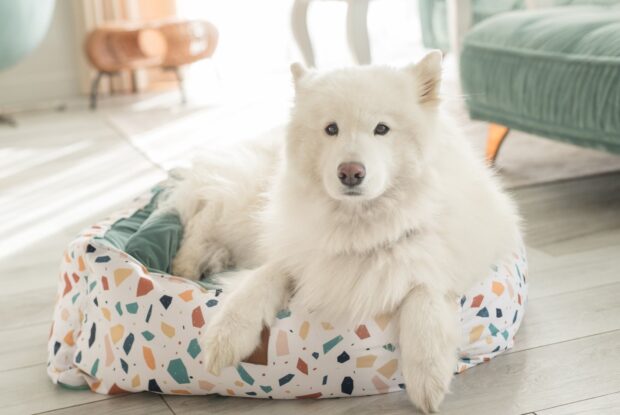Samoyeds, known for their friendly demeanor and fluffy white coats, are beloved companions for many dog owners. However, their affectionate nature often comes with a downside—a strong attachment to their owners, which can lead to separation anxiety. Josiah Grauso explains that this condition is common in Samoyeds and can manifest in various ways, including excessive barking, destructive behavior, and signs of distress when left alone. Fortunately, there are effective strategies to manage and alleviate separation anxiety in Samoyeds, ensuring a happier and more balanced dog.
Understanding Separation Anxiety in Samoyeds
Separation anxiety in dogs occurs when they experience distress and anxiety in the absence of their owners. Samoyeds are particularly prone to this condition due to their history as working dogs that were closely bonded with their human families. These dogs thrive on companionship and can become anxious when left alone, even for short periods.
Common Signs of Separation Anxiety
Identifying separation anxiety in your Samoyed is the first step toward managing it. Common signs include:
- Excessive barking or howling: Your dog may vocalize excessively when you leave the house.
- Destructive behavior: Chewing furniture, digging at doors, or tearing up household items are common signs of anxiety.
- Pacing and restlessness: Your dog may pace around the house or seem unable to settle down when left alone.
- Potty accidents: Even well-trained dogs might have accidents indoors when experiencing anxiety.
- Depression or lethargy: Some dogs may become withdrawn, lose interest in activities, or appear depressed.
If you notice these behaviors, it’s important to address the issue promptly to prevent it from worsening.
Strategies for Managing Separation Anxiety
Managing separation anxiety in Samoyeds requires a combination of training, environmental enrichment, and behavioral techniques. Here are some strategies to help your dog feel more comfortable when left alone:
1. Crate Training
Crate training can be an effective tool in managing separation anxiety. A crate provides a safe and secure space for your Samoyed, where they can relax and feel protected. To make crate training successful:
- Introduce the crate gradually: Allow your dog to explore the crate at their own pace, rewarding them with treats and praise when they enter voluntarily.
- Create a positive association: Make the crate a comfortable and inviting space with soft bedding, favorite toys, and treats.
- Use the crate for short periods: Start by leaving your dog in the crate for short intervals while you’re at home, gradually increasing the time as they become more comfortable.
Crate training helps Samoyeds feel secure and can prevent destructive behaviors that often arise from anxiety.
2. Provide Mental Stimulation
Mental stimulation is key to keeping your Samoyed engaged and less focused on your absence. Boredom can exacerbate anxiety, so it’s essential to keep their minds occupied:
- Interactive toys: Puzzle toys and treat-dispensing toys can keep your dog busy and mentally stimulated.
- Rotate toys: Keep a variety of toys available and rotate them regularly to maintain your dog’s interest.
- Scent games: Hide treats around the house for your dog to find, engaging their sense of smell and providing a fun distraction.
Mental stimulation helps reduce anxiety by keeping your Samoyed’s mind active and engaged.
3. Establish a Routine
Dogs thrive on routine, and establishing a consistent schedule can help reduce anxiety. Try to maintain regular feeding times, walks, and play sessions to create predictability for your Samoyed. Before leaving the house, engage in a calm activity like a short walk or play session to help your dog expend energy and feel more relaxed.
4. Practice Gradual Desensitization
Gradual desensitization involves exposing your Samoyed to short periods of separation and gradually increasing the duration over time. Start by leaving the house for just a few minutes and gradually extend the time as your dog becomes more comfortable. During this process:
- Stay calm: Avoid making a big fuss when leaving or returning home, as this can heighten your dog’s anxiety.
- Use positive reinforcement: Reward your dog with treats and praise when they remain calm during your absence.
This method helps your dog learn that being alone is temporary and nothing to fear.
5. Consider Calming Techniques
There are various calming techniques and products that can help soothe your Samoyed’s anxiety:
- Calming sprays and diffusers: These products release pheromones that mimic a mother dog’s scent, providing comfort to anxious dogs.
- Calming supplements: Consult your veterinarian about natural supplements that can help reduce anxiety, such as those containing L-theanine or chamomile.
- Music and white noise: Playing calming music or white noise can create a soothing environment and mask external sounds that may trigger anxiety.
Calming techniques can be especially helpful during the initial stages of managing separation anxiety.
6. Professional Help
If your Samoyed’s separation anxiety is severe or doesn’t improve with these strategies, it may be necessary to seek professional help. A veterinarian or a certified dog behaviorist can assess your dog’s behavior and recommend additional treatments, such as behavioral therapy or medication.
Managing separation anxiety in Samoyeds requires patience, consistency, and a combination of strategies tailored to your dog’s needs. By providing a secure environment, mental stimulation, and positive reinforcement, you can help your Samoyed feel more comfortable when left alone. Remember, every dog is unique, and it may take time to find the right approach that works for your furry companion. With the right support, your Samoyed can overcome separation anxiety and lead a happier, more relaxed life.
